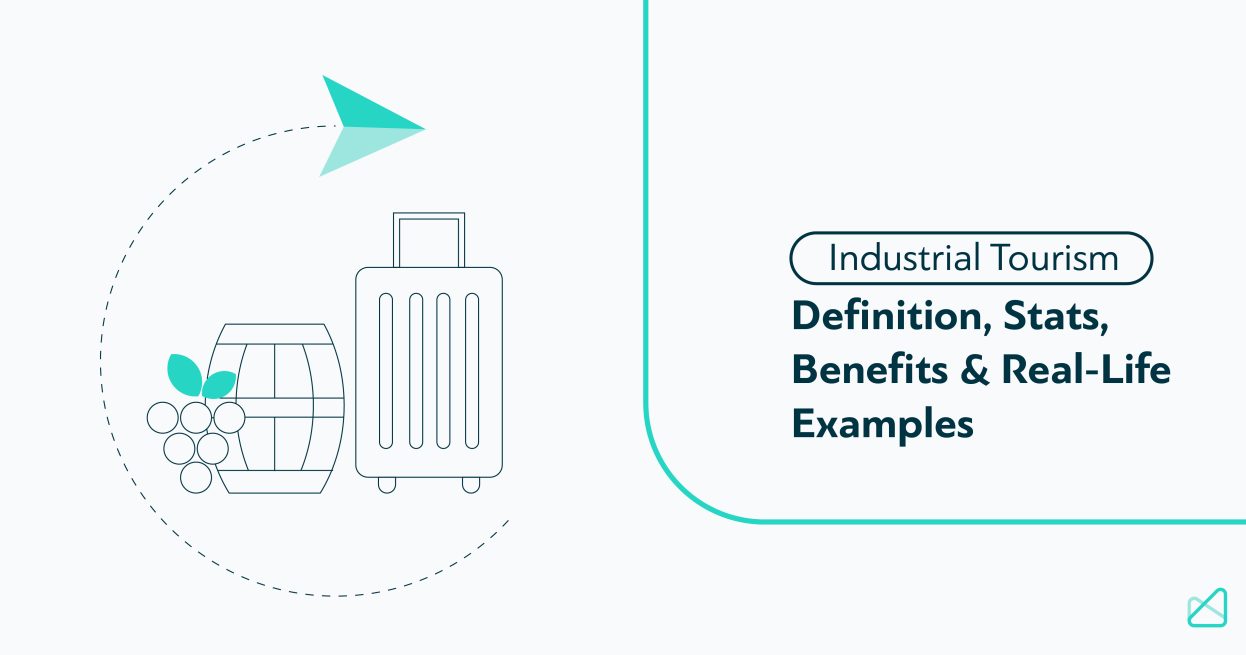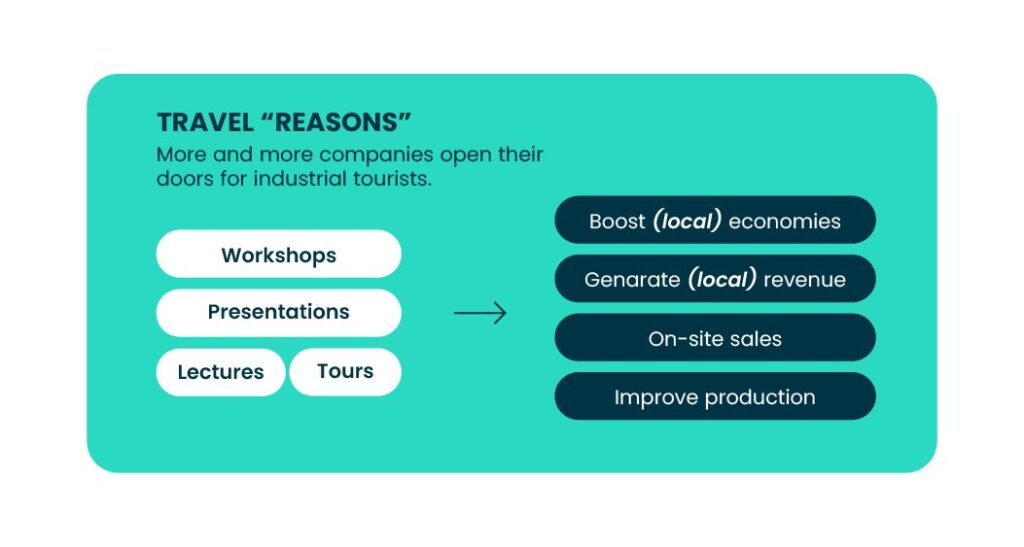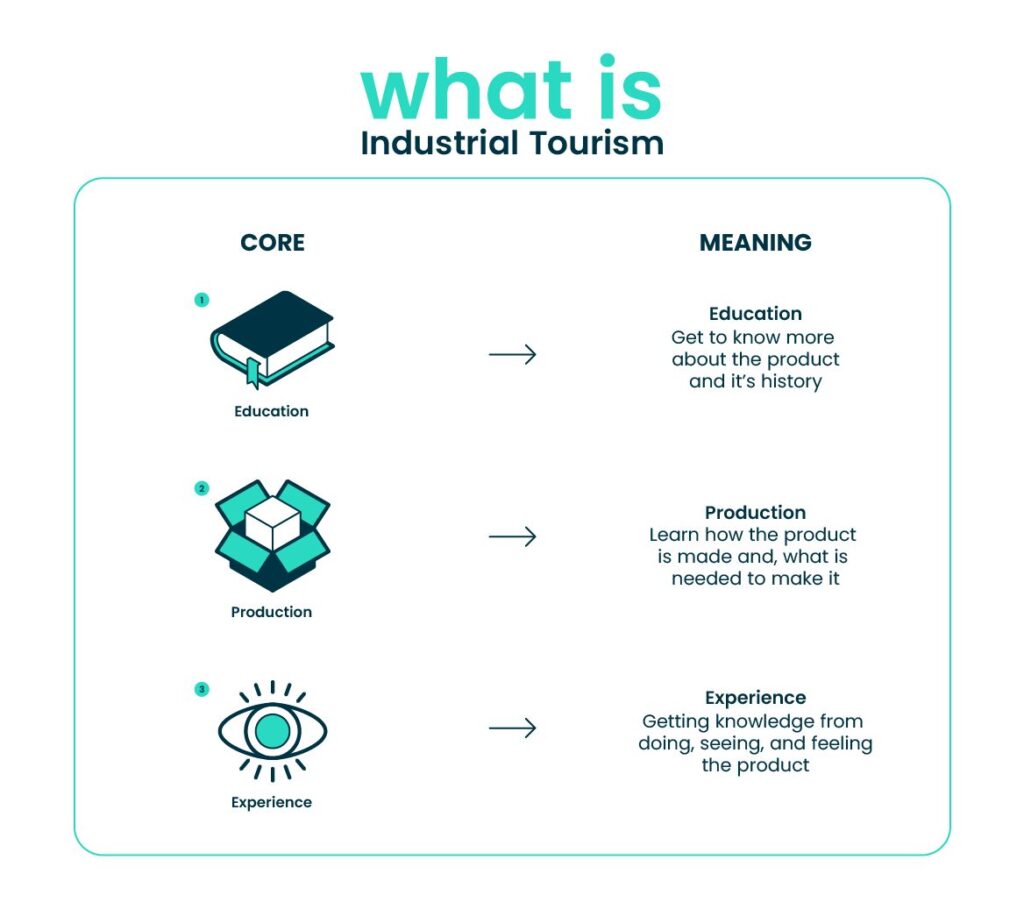What is Industrial Tourism: Definition, Stats, Benefits & Real-Life Examples

The travel sector is one of the most diverse industries out there. With so many moving pieces on the board, it’s hard to stay on top of all developments and make informed business decisions. Industrial tourism is one of the newest additions to the large family of tourism types.
It is one of the growing sub-sectors, and it attracts many companies to explore it further. It’s size is projected to grow at a CAGR of 27.% from 2022 to 2028. However, before deciding whether it is worth your time and money, you need to learn all about it.
We’ve put together a sort of ultimate guide on industrial tourism. Below you will be able to find what industrial tourism is, the most recent and important stats, benefits, real-life examples, and more.
What is industrial tourism?
After the industrial revolution, industries around the globe started flourishing. People got more interested in how products are made, especially in particular details such as the manufacturing process, material sourcing, and specifics regarding operational logistics. That’s why many experts refer to industrial tourism as one of the oldest forms of tourism, but it’s really starting to become popular nowadays.
What is industrial tourism exactly? To understand the consent of industrial tourism, you should learn about educational tourism because industrial tourism is a perfect example of educational tourism.
Educational tourism encompasses all tourism products and services tailored to enable travelers to acquire new information, knowledge, or skills while traveling. In its essence, the definition of industrial tourism reflects the one of educational tourism. However, it’s a bit more specific.
“Industrial tourism is a type of tourism of visiting locations linked to the industries that are most common in those places.”
The definition can get you thinking that it’s a very narrow field. However, industrial tourism is one of the most diverse tourism types. It involves a variety of activities and experiences. Here are some examples:
- Experience firsthand the manufacturing process of a specific product;
- Organized visit to a specific company;
- Organized visit to an industrial heritage site;
- Educational tours with a focus on teaching the history of a particular industry or regional company.
Unlike traditional consumer tourism, which focuses on tourist attractions such as entertainment, sightseeing, and adventure, industrial tourism focuses on education and experience “behind the scenes” aspects of production. In other words, the core activity that tourists engage with is non-tourism-oriented.
Industrial tourism is not reserved only for visiting locations where the manufacturing industry is dominant. Tourists also enjoy visiting sites of handcrafted goods, food, and drink, and branded luxury goods and discovering products that are symbols of a specific geographical region.
Stats about industrial tourism
There are numerous industrial tourism studies and research. One of the most interesting recent findings is that people find industrial tourism as attractive as any other type of tourism. Also, no significant differences were recorded between people of different ages, education levels, and gender.
One of the best ways to keep up with the trends in specific travel industry markets is to track changes in market size and growth rate. The global industrial tourism market size in 2021 was $986 million. It is projected to grow at a CAGR of 27% over the next 6 years to finally reach $1.258 billion by 2028.
The financial benefits of industrial tourism are also being researched. Its potential to revitalize local economies is put under the scope. One thing is certain – industrial tourism can help revitalize post-industrial sites and facilitate the economic development of regions.
Unfortunately, the World Tourism Organisation doesn’t provide stats on industrial tourism or the demand for industrial tourism products. However, we can assess the demand by taking a look at local and national stats.
Australia, more specifically New South Wales, records a 10% increase in demand for industrial tourism packages. France also recorded the same trends with over 8 million people visiting industrial sites in the period of one year.
More and more companies open their doors for industrial tourists. In the UK over 6% of companies are open for visitors and the number keeps increasing.
Industrial tourism market share is increasing across countries. Industrial tourism attractions are especially popular in China. In 2017, 140 million tourists visited industrial sites in China, and the industrial tourism revenue reached $3 billion. The same report outlines the two most popular types of industrial tourism – industrial production tourism and industrial heritage tourism.
The industrial tourism market in Japan is also among the markets with the highest revenue generated per year. Japan’s most popular industrial tourism packages include factory tours, farm tours, craft centers, plant tours, industrial museums, and brewery tours.
In 2020, Japanese Renew received over 30,000 visitors, which is a great success considering how small the industrial tourism-oriented event is compared to other travel-related events.
Benefits of industrial tourism

Local benefits
Industrial tourism offers many benefits. First, it can help boost economies in local regions and even help companies generate additional revenue streams from it. Direct financial benefits for firms that decide to open the door to industrial tourists come from the following:
- Entrance tickets – the entrance fees can significantly help companies stay on top of their finances and even get access to funds to grow and enter new markets;
- On-site sales – on-site sales are an excellent opportunity for companies to generate more revenue. They can sell products available in stores at promotional prices or develop a brand-new product line only available to industrial tourists.
There are also reputational benefits. Industrial tourism can help companies improve their brand image, promote products and services, and build long-lasting customer relationships.
Industry benefits
Finally, industrial tourism offers opportunities to travel agents and OTAs as well. It can help them diversify their travel product offer, attract more tourists, and capture more revenue.
Industrial tourism packages are suitable for OTAs of all sizes and individual travel agents. They can help them deliver more attractive product portfolios, gain a competitive advantage, and attract consumers interested in industrial tourism packages.
Who is it for?
Industrial tourism is a go-to option for people who want to get more out of travel. It’s a perfect choice for travelers who want to satisfy their intellectual curiosity and learn details regarding product design and manufacturing. As more people are stepping away from traditional vacation travel and wanting to try alternative travel, industrial tourism presents itself as a viable opportunity to explore.
This type of tourism allows travelers to discover new locations and experience exclusive “behind-the-scenes” arrangements. They can learn how their favorite products are made, taste the local food and beverage, and learn new historical facts about the region and local industry.
Types of industrial tourism
Industrial tourism is one of the most dynamic travel sectors. It continues to accommodate the needs of industrial travelers. While there are some shifts in industrial tourism trends from time to time, we can talk about specific types and forms of industrial tourism.
Based on the on-site activity and experience, we can divide industrial tourism into several types:
- Factory tours – these tours include organized visits to one of the prominent factories in the region. The most common goals are to enable travelers to learn about the manufacturing process and discover the company’s history;
- Work watching – work watching enables travelers to learn details about specific manufacturing processes, which is quite fun and engaging in some industries;
- Farm tours – farm tours put travelers in a unique position to firsthand experience life on a farm and discover details about different processes that take place at farms;
- Mine tours – some tourists enjoy taking a trip underground to visit old and abandoned or still operational mines;
- Wine tours – wine tours are extremely popular among tourists who enjoy quality wines and want to explore famous wine regions, see the wine production in person, and taste different wines.
Industrial tourism doesn’t only include visits to places that are currently operational. Many industrial tourists enjoy visiting closed factories and mines. Some of the old factories are turned into museums, restaurants, and art galleries. These locations enable a sub-sector of industrial tourism called post-industrial tourism.
Each one of these locations offers a unique experience and an exciting story to learn. Based on the locations and activities tourists like to explore and experience, industrial tourists can be divided into the following categories:
- Stalkers – these tourists are interested in visiting closed and abandoned locations for industrial purposes;
- Diggers – this term is used to describe tourists who prefer underground locations such as sewers and catacombs;
- Roofing – roofing is a type of industrial tourism that attracts tourists comfortable with heights. You can find these tourists visiting dams and skyscrapers.
Real-life examples
The best way to understand what industrial tourism is all about is to look at some real-life examples. Below you can find some noteworthy industrial tourism examples.
Industrial heritage sites in Katowice and Silesia region
The Silesia region in Poland is considered an industrial tourist goldmine. It has an abundance of overgrown slag heaps and derelict factories. Industrial tourism is flourishing in these parts. There is even an official Silesian Industrial Monuments Route specifically tailored for industry-savvy tourists.
One of the most popular destinations in Katowice is a former Katowice Coal Mine and Industrial Ethnography Museum in the Nikiszowiec district.
The attractive industrial tourism destinations in Kawasaki, Japan
Kawasaki is the industrial tourism center of Japan. It has more than a few attractive destinations tourists can explore. Most importantly, the destinations offer completely different experiences, thus making the entire region attractive to industrial tourists from all corners of the world.
The most noteworthy destinations include:
- Kawasaki Mari-in – this is the main city’s port which tourists can explore on foot or from the observation deck;
- Toshiba Science Museum – this museum is perfect for travelers who want to learn everything there is to know about the Toshiba brand;
- Kawasaki EcoLife Museum of the Future – a go-to destination for travelers interested in renewable energy solutions;
- Ajinomoto Umami Science Square – this is a place where tourists can do various things ranging from tasting umami to creating Ajinomoto.
Japan has to offer other sites apart from Kawasaki, including the Noritake Company near Tokyo and the Toyota Commemorative Museum of Industry and Technology.
Diverse industrial tourism offer in Minsk, Belarus
Minks, Belarus, is another popular destination on every industrial traveler’s map. As the industry center of Belarus, Minsk has a lot to offer. Travelers can learn all about the products, interesting places, and secrets of some of the biggest Belarus brands.
Some of this city’s most famous industrial tourism attractions include Minsk Tractor Plant, Beer Tour in the Alivaria Brewery, and Gold Tour in the Minsk Jewellery Factory Zorka.
Gujarat, India, is the industrial tourism country’s center
India has one of the most diverse tourism offers. Industrial tourism is one of the tourism types available in this country. The most noteworthy example is the Gujarat region, the Anand-Amul Dairy factory, a historic place with great importance for the entire region. In fact, this factory focuses on producing sweets, ice cream, butter, and ghee and was the main cog in the milk revolution machine, which changed the region forever.
The Catalan capital’s industrial tourism attractions
Barcelona is most famous for its remarkable architecture. However, recently, tourists have recognized its incredible industrial tourism potential. The majority of the main attractions are close to the city.
Some of the most popular ones are Colonia Gell which is unique for its use of steam energy; Colonia Sedo, with a museum to enable visitors to understand the everyday life at this cotton colony – and the prominent textile colony of Colonia Borgonya.
The Italian archipelago Murano and its attractive industrial tourism offer
Venetian lagoon in Italy is famous for Murano – an island known for Murano glassware. Many people refer to Murano as an island while it’s in fact a collection of islands (archipelago) connected by bridges. The island’s glass manufacturing industries deliver some of the most unique and colorful products.
The glass industry’s colorful and mesmerizing products are not the only thing that interests industrial tourists. The glass industry in these parts has 8 centuries of engaging industry travelers can learn. Additionally, tourists can visit the Murano Glass Factory and see glass masters blow glass work on site.
Conclusion
Industrial tourism is definitely gaining in popularity. There are many unique types, each offering different experiences and levels of engagement. Consumers have many options to choose from, as do travel agents and OTAs.
As you can see, some regions, factories, and countries are already reaping all the benefits this tourism type has to offer. It’s safe to assume that industrial tourism will become even more popular in the foreseeable future with new generations of tourists coming of age to travel on their own and have memorable experiences.
Subscribe to
our newsletter
Yay! You are now
subscribed to our
newsletter
Mize is the leading hotel booking optimization solution in the world. With over 170 partners using our fintech products, Mize creates new extra profit for the hotel booking industry using its fully automated proprietary technology and has generated hundreds of millions of dollars in revenue across its suite of products for its partners. Mize was founded in 2016 with its headquarters in Tel Aviv and offices worldwide.
Related Posts

30 Most Important Travel Industry Events for 2024
30 min. Social share: 2024 is packed with must-attend travel industry events. Stop by to discover all relevant events conveniently grouped by continents with listed dates, themes, and locations! Many travel industry experts believe that travel industry events play a pivotal role in shaping the future of the travel industry. Why is this so? It’s […]

Empowering Equality: Mize Leads the Way in Travel Technology
7 min. Are we all equal? Are we all equally represented in the business world? In some professional sectors, there might still be some under-representation of women, minorities, and the LGBTQIA+ community. The tech sphere is no different, but is the travel tech sector a spark of hope? As the business world becomes more diverse, […]

Slow Tourism Case Studies: Examples to Truly Understand Slow Tourism
14 min. The tourism industry is moving at an ever-accelerating pace. That’s because the tourism industry is perhaps one of the verticals that depend on the most factors. One of the main factors that affect it is social movements, given that tourism brands of all sizes always cater to the needs of consumers. One of […]
